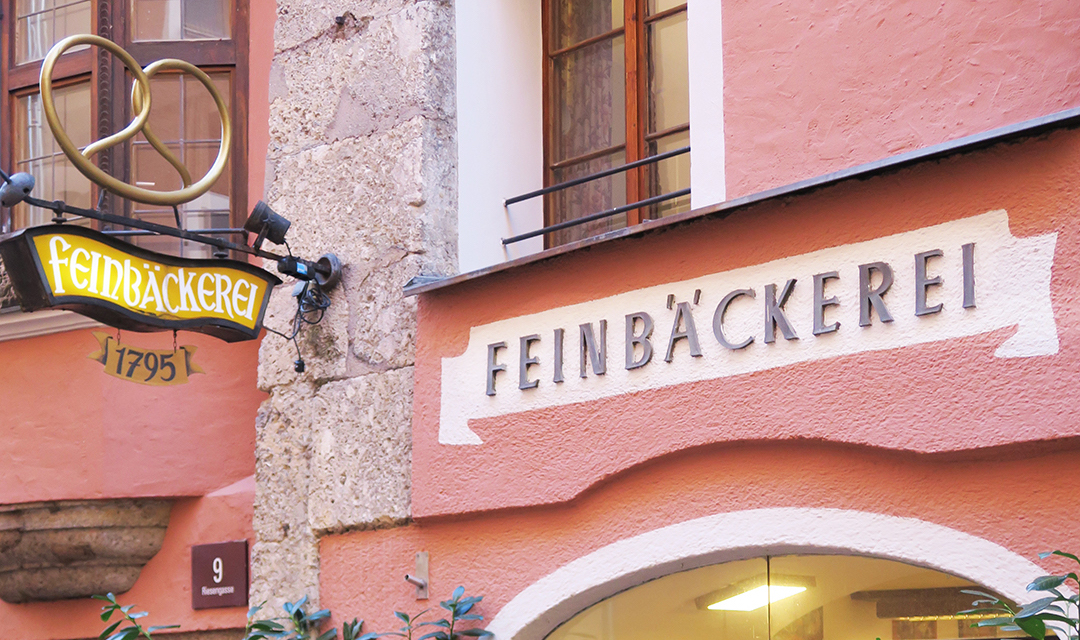
Just look around: we are surrounded by all kinds of messages delivered through typefaces. Typefaces to text is like melodies to lyrics. They are the clues of the pitches, tempos, dynamics and moods of the words.
On the other hand: are the words printed on paper, illuminated by light, or carved in stone? The materials are the timbres chosen for the songs.
"Typowalks": appreciation of typefaces
These encoded messages add fun to our cityscapes and now Innsbruck has its own online guide highlighting interesting typefaces. This web app is called "Typowalks" and can be found here: typowalks.weissraum.at/en/
The app is web-based and therefore, there is no need to install any app. Just set the browser on your device to portrait mode and you are good to go! (Scale the browser width down if you view it on the computer.)
Tips
- I would recommend watching all the orientation videos before setting off. They are not very long and all have English subtitles.
- If you grant the app the permission to use your location (it's optional), the map in the app will update your location as you move around.
Connect the Dots
The tours are led by graphic designer Markus Weithas. There are five themed walks featuring about 30 locations. Here are some examples:
Political Power
Capitalis Monumentalis, also called Roman Square Capitals, was the typeface frequently used for imperial inscriptions in ancient Roman times. The most famous example is probably the Trajan’s Column dedicated to the mighty Roman emperor.
This all-capital typeface commands authority and supremacy. No wonder it was used on the Triumphal Arch/Triumphpforte in Innsbruck which commemorated the royal wedding of Archduke Leopold.
The front of the Liberation Monument on Landhausplatz/Eduard-Wallnöfer-Platz also uses Capitalis Monumentalis as the monument bares the status of the state of Tyrol.
Typeface "Gebrochene Grotesk" was once favoured by the Nazi regime. Find out its story in the app "Typowalks".
Tyrolean Modernism in the 1920s and 30s
In the 1920s, Modernism brought refreshing new flavours to Innsbruck. Former brewhouse Adambräu was designed during this time by Tyrolean architect Lois Welzenbacher. The sleek typeface on the façade compliments the geometric architecture. This iconic building was converted in 2003-2004 and since then it became the hub of the architecture scene in Tyrol.
Arthur Zelger
The distinctive "Tirol" logo was originally designed by Arthur Zelger who was the most prominent graphic artist in Tyrol between 1945 and the early 2000. He created many characteristic designs in and around Innsbruck and this walk traces his imprints.
Independent Stores
The fourth walk introduces the logos of local shops in Innsbruck, while the fifth focuses on the use of neon lights.
Millinery Held, Franziskanerplatz, Franziskanerplatz © Ichia Wu
Miller Optics, Meraner Straße © Ichia Wu
Explore Topographical Treasures
Once you start looking, more and more treasures reveal themselves to you. The following locations are not included in the Typowalks app — they are quests for you to solve!
Leopoldstraße © Ichia Wu
Old Town © Ichia Wu
Glasmalereistraße © Ichia Wu
Glasmalereistraße © Ichia Wu
Old Town © Ichia Wu
Bozner Platz © Ichia Wu
Old Town © Ichia Wu
House Number Plaques © Ichia Wu
Old Town © Ichia Wu
Old Town © Ichia Wu
Innsbruck Logo, in use since 2010 © Ichia Wu
Adolf-Pichler-Platz © Ichia Wu
* Typowalks is a project by WEI SRAUM, motasdesign and Wir sind Plural.
Rate this article
Show me the location on the map
Ichia Wu is a Taiwanese artist with broad experience in the tourism sector. Since relocating to Innsbruck, she has become an ardent enthusiast of the traditional carnival celebrations ("Fasnacht") in Tyrol.
Similar articles
The museum in Innsbruck's Arsenal "Museum im Zeughaus" was reopened on April 6,…
The Ferdinandeum regional museum is open until June 30, 2024, with exhibitions and events. Then a…
A purely Tyrolean film project aims to shed new light on the novel story of probably…
With the Alpine Jitterbugs, Innsbruck has a club that is passionately dedicated to swing dancing. The Alpine…
































